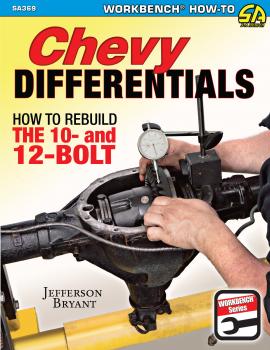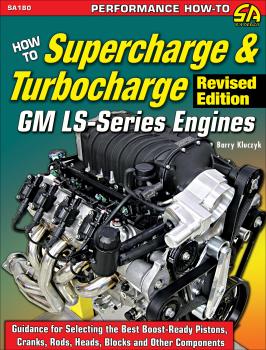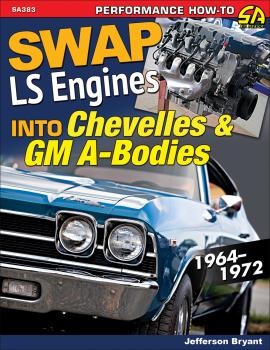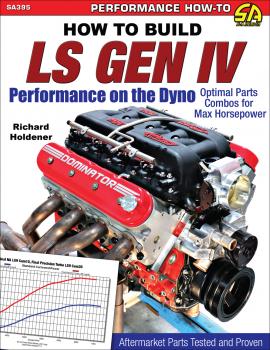Сделай Сам
Различные книги в жанре Сделай СамFord Flathead Engines
Authors Thacker and Herman take you through the entire process of a Ford flathead rebuild, including teardown, parts inspection, machine shop processes, replacement part selection, re-assembly, start up, and break-in. It all adds up to more than 500 color photos and insider tips on building what could be called the most iconic engine ever built, the Ford flathead V-8.
New Hemi Engines 2003-Present
When Chrysler released the «new» third-generation Hemi engine in 2003, the automotive public placed high expectations on the Hemi’s triumphant return. The Hemi Gen III 5.7L, 6.1L, and 6.2L supercharged and 6.4L engines didn’t disappoint; they produced copious amounts of horsepower and torque while delivering exceptional durability. These powerful engines occupy the engine bays of new Challengers, Chargers, Magnums, 300C, Durangos, Jeep Grand Cherokees, and Ram trucks. Many of these engines have been used for high-performance service or logged hundreds of thousands of road miles, and as a result, many need to be rebuilt. <p>Long-time Mopar engineer, racing coordinator, and veteran author Larry Shepard delivers thorough instructions for each crucial step of the rebuilding process. Before commencing engine tear down, Shepard shows you how to perform compression and leak down testing to accurately assess the health of the engine. Disassembly and comprehensive inspection instructions are provided so you can determine and remedy any underlying problems. Expert insight allows you to select the ideal parts package for your rebuild, whether OEM replacement or compatible and complementary high-performance parts are selected. The most pertinent information for the latest machining practices is provided, so you can coordinate with the machine shop to return the block, head, intake, and other surfaces to like-new condition. Assembling the cylinder heads as well as accurately measuring, checking clearances, and test fitting parts is detailed, so you’re sure all components are within spec and ready for final assembly. Finally, comprehensive step-by-step instructions are provided for assembling all components into a completed engine. <p>The modern Hemi engine is lighter and stronger and offers far better drivability and performance than its predecessors. However, after hundreds of thousands of miles, extreme use, or high-performance applications, these rugged engines require a professional caliber rebuild. With this book, you can confidently complete your Hemi rebuild and get your car or truck back into action.
GM Turbo 350 Transmissions
GM Turbo 350 Transmissions: How to Rebuild & Modify guides you through the complex rebuild procedure of GM’s popular rear-wheel-drive automatic transmission. This is the only book on this subject in full color.
Chevy Differentials
Millions of Chevrolet vehicles were built and sold in the 1960s and 1970s, and the great majority of those were rear-wheel-drive models with differentials known as 10-bolts or 12-bolts. In Chevy Differentials: How to Rebuild the 10- and 12-Bolt, author Jefferson Bryant walks you through the entire process of procuring, evaluating, and rebuilding the perfect differential for your GM application.
Holley Carburetors
Author Mike Mavrigian guides you through each important stage of the Holley carb rebuilding process, so you have the best operating carburetor for a particular engine and application. In addition, he explains carb identification as well as idle, mid-range and high-speed circuit operation, specialty tools, and available parts.
How to Supercharge & Turbocharge GM LS-Series Engines - Revised Edition
GM LS-series engines are some of the most powerful, versatile, and popular V-8 engines ever produced. They deliver exceptional torque and abundant horsepower, are in ample supply, and have a massive range of aftermarket parts available. Some of the LS engines produce about 1 horsepower per cubic inch in stock form–that's serious performance. One of the most common ways to produce even more horsepower is through forced air induction–supercharging or turbocharging. Right-sized superchargers and turbochargers and relatively easy tuning have grown to make supercharging or turbocharging an LS-powered vehicle a comparatively simple yet highly effective method of generating a dramatic increase in power. <p>In the <b>revised edition</b> of <i>How to Supercharge & Turbocharge GM LS-Series Engines</i>, supercharger and turbocharger design and operation are covered in detail, so the reader has a solid understanding of each system and can select the best system for his or her budget, engine, and application. The attributes of Roots-type and centrifugal-type superchargers as well as turbochargers are extensively discussed to establish a solid base of knowledge. Benefits and drawbacks of each system as well as the impact of systems on the vehicle are explained. Also covered in detail are the installation challenges, necessary tools, and the time required to do the job. Once the system has been installed, the book covers tuning, maintenance, and how to avoid detonation so the engine stays healthy. Cathedral, square, and D-shaped port design heads are explained in terms of performance, as well as strength and reliability of the rotating assembly, block, and other components. <p>Finally, Kluczyk explains how to adjust the electronic management system to accommodate a supercharger or turbocharger. <i>How to Supercharge and Turbocharge GM LS-Series Engines</i> is the only book on the market specifically dedicated to forced air induction for LS-series engines. It provides exceptional guidance on the wide range of systems and kits available for arguably the most popular modern V-8 on the market today.
Jeep Wrangler YJ 1987-1995
Jeepers rejoice! Bring new life to your classic Jeep YJ with this new guide to off-road performance. More than 685,000 YJs were built from 1986 to 1995. They featured heavier wider leaf springs, track bars, and sway bars for improved handling. A massive range of parts are offered for these vehicles, which include lift kits, wheels up to 37 inches, larger brake rotors, high-performance aluminum remote reservoir shocks, stronger driveshafts and U-joints, and Dana 60 conversions. In Jeep Wrangler YJ 1987-1995: Advance Performance Modifications , veteran author Don Alexander covers the 4.0 engine, transmissions (automatic and manual), transfer cases, axles, differentials, and driveshafts, steering boxes, brake upgrades, shocks, springs and lift kits, chassis strengthening, and interior upgrades. Whether you want to do some simple upgrades, such as a lift and tire combination, or want to go all out with a rock crawler-style suspension and an engine swap, this book will guide you through the process.
Ford Big-Block Parts Interchange
Over the course of performance car history, and specifically muscle car history, big-block engines are particularly beloved, and for good reason. Not only are they the essence of what a muscle car is, but before modern technology and stroker engines, they were also the best way to make a lot of horsepower. All of the Detroit manufacturers had their versions of big-block engines, and Ford was no exception. Actually, Ford was somewhat unique in that it had two very different big-block engine designs during the muscle car era.<p>The FE engine was a design pioneered in the late 1950s, primarily as a more powerful replacement for the dated Y-block design because cars were becoming bigger and heavier, and therefore, necessitated more power to move. What started as torquey engines meant to move heavyweight sedans morphed into screaming high-performance mills that won Le Mans and drag racing championships through the 1960s. By the late 1960s, the design was dated, so Ford replaced the FE design with the «385» series, also known as the «Lima» design, which was more similar to the canted-valve Cleveland design being pioneered at the same time. It didn't share the 1960s pedigree of racing success, but the new design was better in almost every way; it exists via Ford motorsports offerings to this day.</p><p>In <i>Ford Big-Block Parts Interchange</i>, Ford expert and historian George Reid covers these engines completely. Interchange and availability for all engine components are covered including cranks, rods, pistons, camshafts, engine blocks, intake and exhaust manifolds, carburetors, distributors, and more. Expanding from the previous edition of <i>High-Performance Ford Parts Interchange</i> that covered both small- and big-block engines in one volume, this book cuts out the small-block information and devotes every page to the MEL, FE and 385 series big-blocks from Ford, which allows for more complete and extensive coverage
Swap LS Engines into Chevelles & GM A-Bodies
The GM LS engine has revolutionized the muscle car and the high-performance V-8 market. It has become a favorite engine to swap into classic cars because it offers a superior combination of horsepower, torque, and responsiveness in a compact package. As such, these modern pushrod V-8 engines are installed in vintage GM muscle cars with relative ease, and that includes Chevelles and other popular GM A-Body cars. In fact, General Motors manufactured about 500,000 Chevelles and A-Body cars between 1968 and 1970 alone.<p>Jefferson Bryant, author of <i>LS Swaps: How To Swap GM LS Engines into Almost Anything</i>, has performed many LS swaps throughout his career, and has transplanted the LS into several A-Body cars. In this comprehensive guide, he provides detailed step-by-step instructions for installing an LS powerplant into a Chevelle, Buick GS, Oldsmobile Cutlass, and Pontiac GTO. To successfully install an LS engine, you need to select or fabricate motor mounts and adapter plates to mount the engine to the chassis. Also, you need to integrate the electronic engine controls and wiring harness to the A-Body car. If you run a fuel-injection system, a new tank or high-pressure fuel pump, fuel lines, and related equipment must be installed. Bryant covers all of these crucial steps and much more. He explains essential procedures, time saving techniques, and solutions to common problems. In addition, he performs a new LT swap into an A-Body car. <p>Swapping an LS engine into an A-Body is made much easier with a comprehensive guidebook such as this, whether you plan on doing it yourself or decide to have a shop do it for you. A huge and thriving aftermarket provides a wide range of suspension, brake, steering, chassis, and other parts that produce functional improvements. Before you tackle your LS Swap project, arm yourself with this vital information to guide you through the process.
How to Build LS Gen IV Performance on the Dyno
The GM LS engine has redefined small-block V-8 performance. It's the standard powerplant in many GM cars and trucks and it has been installed in a variety of muscle cars, hot rods, and specialty cars to become the undisputed sales leader of crate engines. The aftermarket has fully embraced the GM Gen IV LS engine platform offering a massive range of heads, intakes, pistons, rods, crankshafts, exhaust, and other parts. <p>Seasoned journalist and respected author Richard Holdener reveals effective, popular, and powerful equipment packages for the Gen IV LS engine. With this information, you can select the parts to build a powerful and reliable engine by removing the research time and guesswork to buy a performance package of your own. In this book, performance packages for high-performance street, drag race, and other applications are covered. And then the assembled engine packages are dyno tested to verify that the parts produce the desired and targeted performance increases. This comprehensive build-up guide covers intakes, throttle bodies, manifolds, heads and camshafts, headers and exhaust, engine controls, superchargers and turbochargers, and nitrous oxide.<p>With so many parts available from a myriad of aftermarket companies, it's easy to become confused by the choices. This book shows you a solid selection process for assembling a powerful engine package, shows popular packages, and then demonstrates the dyno results of these packages. As such, this is an indispensible resource for anyone building GM LS Gen IV engine.









